Love it or hate it, keyword research is a necessary part of the SEO content planning process.
That’s because your target keywords not only give search engines an indication of what your content is about but ultimately serve the purpose of attracting more visitors to your website.
Creating a high volume keywords list is absolutely essential. This means finding the best keywords with very little competition and a high volume of organic traffic.
But how do you find these keywords that hit the “sweet spot” of getting a lot of traffic without being highly competitive?
In this guide, I’m going to walk you through how to identify low competition, high traffic keywords to target in your SEO content.
Why Low Competition, High Volume Keywords are the SEO ‘Sweet Spot’
My guess is you have a lot of questions when it comes to keyword research – and they deserve answers.
All website owners that get started with SEO want traffic – and a lot of it. The more traffic, the better, right?
Well, the problem is that the keywords that get the most traffic tend to also be the most competitive. This means that many other websites are targeting these same keywords.
Just take the term “Thailand travel”, as an example.
It gets over 12,000 organic searches per month, but there are over 1 BILLION results. That’s a lot of possible competition. (This is confirmed by its competition score of 0.60 out of 1.0)

While it may seem smart to target “Thailand travel” to grab a piece of that traffic pie, know that’s you’ll be up against some high-authority websites (Like Lonely Planet and Travel and Leisure) that are targeting the same keyword.
Your chances of ranking? Pretty slim.
Just like there are many people Googling these high-volume keywords, there are many websites vying for those top 10 spots in the search results. And if your website is relatively new, doesn’t have much authority online, or is just in a competitive industry, it may be next to impossible to outrank the competition.
That’s why low competition/high volume keywords are the sweet spot. They aren’t so competitive that you don’t have a chance of ranking for them, but they still get enough search volume to make them worth your time.
These are the best terms to target because you can pursue them with confidence without wasting your time (or budget) on creating SEO content that isn’t going to rank.
How Low is “Low Competition”?
Wordstream defines “keyword competition” as: “the measure of how difficult it will be to rank for a particular keyword”. Further, “the competition for a keyword can vary depending on how popular the keyword is and industry competition.”
Therefore, what’s considered “low competition” is pretty relative.
If you are already in a competitive industry – one with lots of businesses going head-to-head over the same keywords – then your competitive “floor” may be higher than that of less competitive industries.
For example, a local ATV rental business that has 2 local competitors can be fairly confident that, with the right SEO strategy, they can make it to at least the first page of the Google search results (there are only about 10 spots, after all). It’s safe to say that only a few sites are going after the same keywords.

By contrast, a personal injury attorney in Los Angeles with dozens of competitors will have to be much more strategic. There are many websites (more than what can fit on the first page of Google) all targeting the same keywords. If you are a newbie in the space, you may not want to go after the big fish (i.e. the highly-competitive keywords) quite yet.
How High is “High Traffic”?
Again, this is relative.
Using the same examples as above, let’s look at the search volume for the terms “arizona atv rentals” and “los angeles personal injury lawyer”. Both of these terms are relatively broad, yet specific enough to give a clear indication of what the user is looking for.
“Arizona atv rentals” gets about 720 organic searches per month.

“Los angeles personal injury lawyer” gets about 2,400 organic searches per month.

So, which keyword is considered “high volume”?
Well, if we consider that more people are likely looking for a lawyer (and more often) than they are an ATV to rent, the difference in search volume makes sense. 720 searches for an ATV in Arizona may be considered high-volume for the ATV industry. 2,400 searches for a PI lawyer in Los Angeles may be considered high volume for the legal industry.
To further gauge this, we can see that the more specific we get with the keywords, the lower the search volume is.
In the ATV rental case, the following keywords only get about 50 or 20 searches per month:
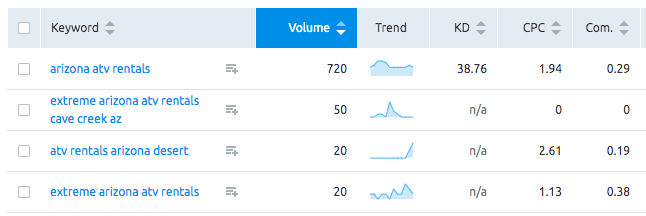
Meanwhile, other keywords related to “los angeles personal injury lawyer” still get 320, 170, 50, and 40 searches per month:
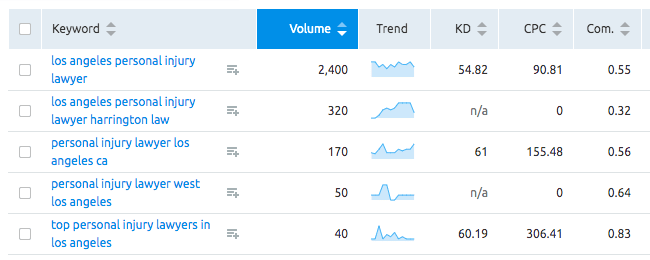
Therefore, we can conclude that “arizona atv rentals” is a relatively high volume keyword for that market (ATV businesses in Arizona), and that “los angeles personal injury lawyer” is a relatively high volume keyword for that market (PI lawyers in Los Angeles).
When considering competition and search volume levels, always look at your own industry numbers. You’ll be able to determine a range between the lowest volume keywords and the highest volume keywords. Keywords that fall at the high end of the spectrum (e.g. 720 for ATV rentals and 2,400 for PI attorneys in LA), will be considered “high volume” for your industry.
Knowing all of this, my process for determining what’s considered “low competition” involves looking at accurate keyword competition data AND analyzing the websites that are already ranking for a given keyword. I’ll break down how to do this in a later section.
A Note About Determining the “Sweet Spot” for Your Industry:
Remember to start with terms that are still specific enough to match the user’s search intent. For instance, doing keyword research for “atv” is way too broad, as it neither indicates what the user wants (To buy? To sell? To learn about ATVs?) or where they are searching. “Arizona atv rentals” is a good keyword because it tells us what the user is looking for (ATVs), what their goal is (to rent an ATV), and where they are searching for services (Arizona).
Being a bit more specific with your keywords will help you set a more accurate range for what’s considered low to high competition or low to high traffic for your industry.
Step 1 – Build a “Seed List” of SEO Keywords
Before you get too focused on the competition level and search volume, you need to first create a general keyword list.
We call this a “seed list” of keywords because this is our starting off point. Later, we will refine this list by removing some keywords and adding new ones.
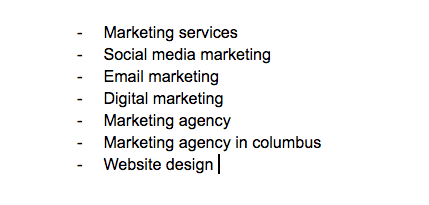
You may have a seed list of sorts already – perhaps a list of keywords that you think you want to target, or keywords that you notice your competitors are targeting. If so, start there. If not, no worries – it’s super easy to get started with a blank slate.
To create (or add to) your list of Google keywords, brainstorm keywords according to each category below to get the wheels turnin’.
I recommend using a spreadsheet – like Google Sheets – to keep your list organized.
Branded Terms
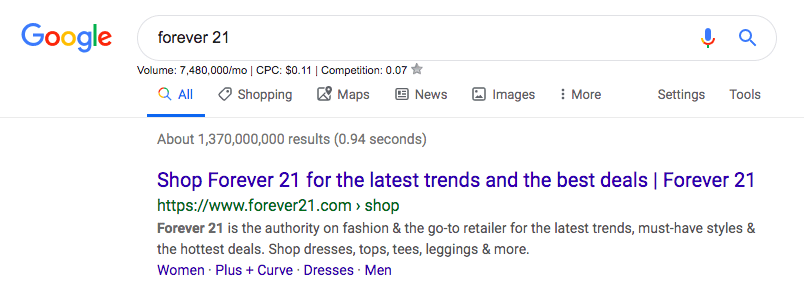
Are there any specific brand terms you want to rank for?
If your business has been around for a while, and people have likely heard of your brand before, you will definitely want to rank high for these terms (add ‘em to the list). If, however, your brand name is more obscure and/or you suspect users aren’t liking searching for the name directly, it may be worth skipping over these. Over time, your site may start to rank for these naturally
User-Suggested Terms
Your audience – i.e. your followers and existing customers – is a great source of keyword ideas.
Simply scroll through the comments section on your blog and social media profiles to find common questions or concerns your customers have.
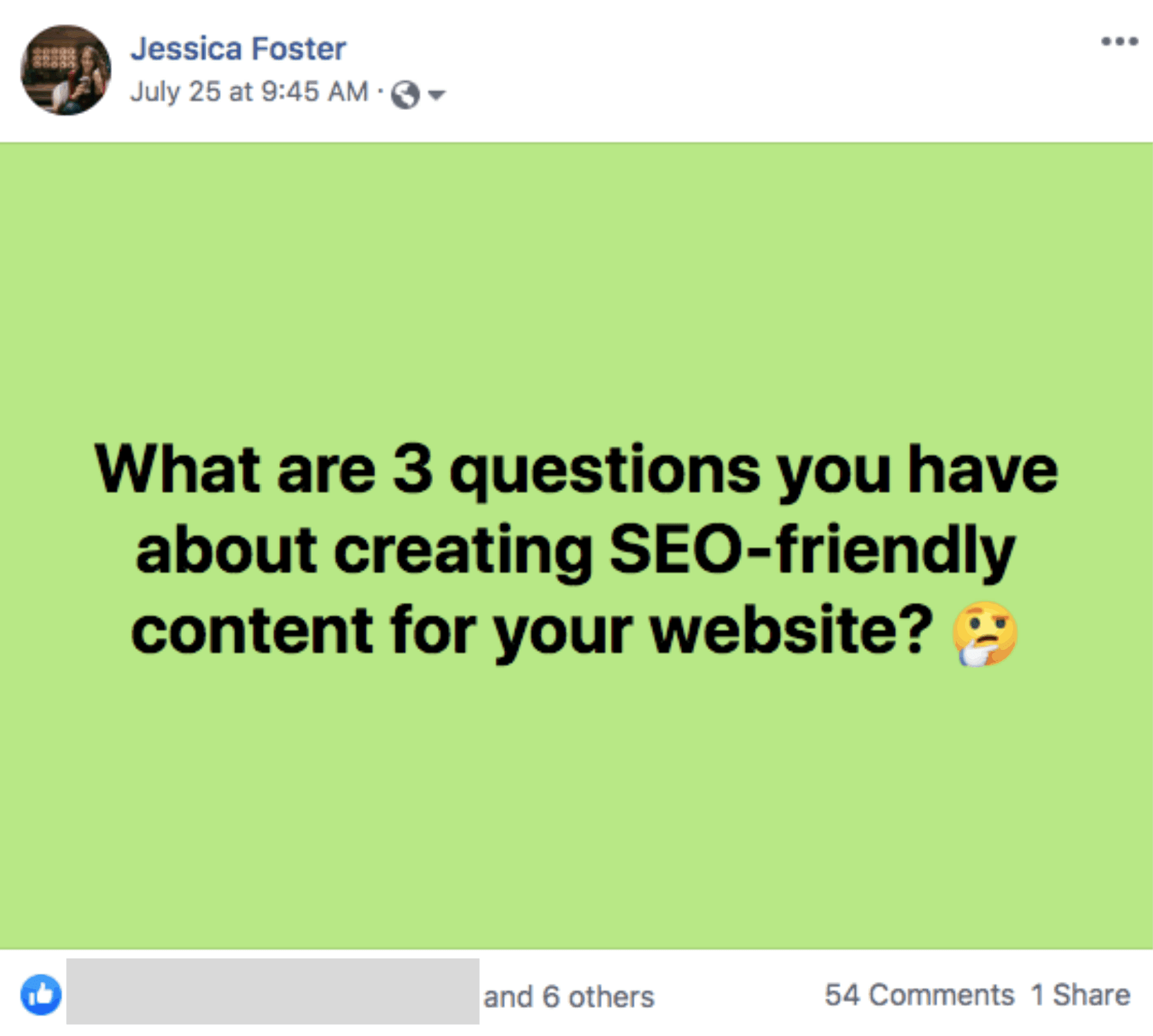
You can even ask your audience directly by sending them a market research survey asking questions like “What questions do you have about [ topic ]?” and “What terms do you use when searching for information about [ problem ]?”
Products and Services
If your business offers products and/or services, you’ll definitely want to add these terms to your seed list. This is because these same keywords will likely work to attract users who are searching for products and services like yours.
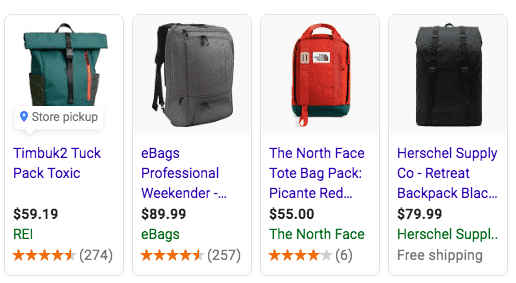
For this category, you’ll want to be more exhaustive. Add as many potential keywords as you can think of that relate to the services and products you sell. Later on, it’ll be essential to try and get your website to rank for these keywords.
Related Terms
Can you think of any terms that are loosely related to the terms you already have on your list? These terms (i.e. related keywords) can prevent more opportunities to rank in the search results.
For example, if you have a travel site and plan to publish articles related to “Thailand travel”, some good related terms may be keywords like “thailand travel tips”, “travel in thailand”, or “thailand travel guide”. You can come up with these terms on your own or by using a tool (like Keywords Everywhere) to generate a list of related keywords for you.
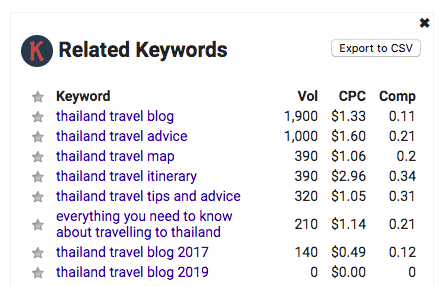
Once you refine your keyword list, you may find that these keywords still get a lot of search volume, but are far less competitive than the broader terms on your list.
Competitor Terms
Analyzing your competitors’ websites is one of the best ways to identify keywords you may have otherwise never thought of before. Why wrack your brain when you could simply uncover which keywords your competitors are targeting?
You can find these terms manually by looking at their existing content (look at what they are writing about on their blog) or by using helpful SEO tools.

Tools like SpyFu and SEMrush allow you to see which keywords your competitors are targeting, which keywords they are ranking for, and which content pieces are targeting those keywords.
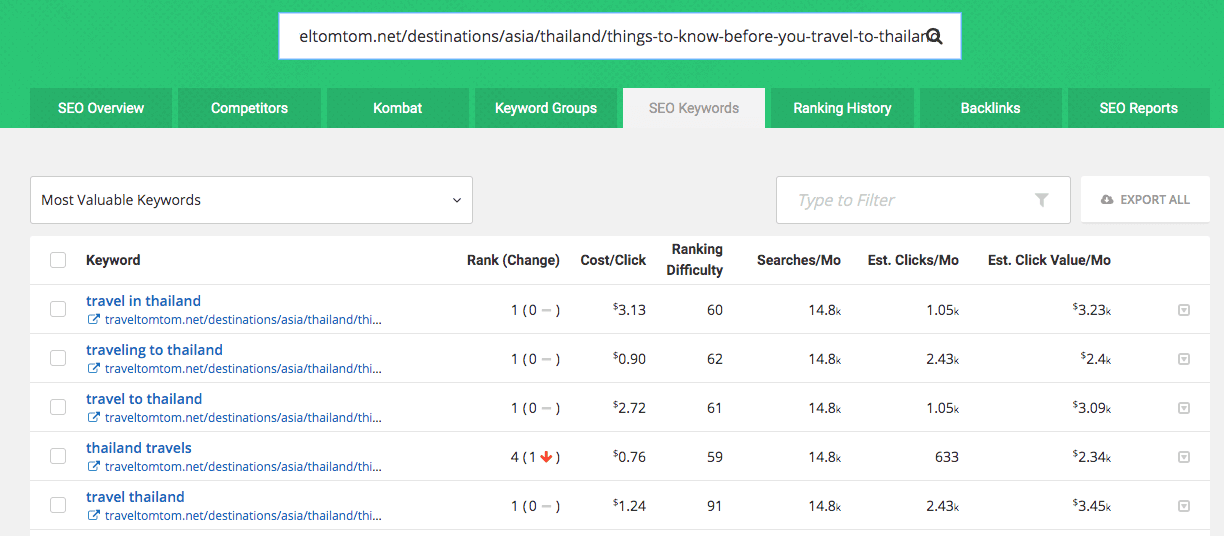
Read on to find out how to further use these SEO tools to refine your keyword list based on their competition and traffic numbers.
Step 2 – Use SEO Tools to Identify High Traffic, Low Competition Keywords ( + Free Tools)
If looking at data and numbers and graphs makes your eyes glaze over, have no fear. Creating your keyword list is stupid easy when you have the right tools at your disposal.
That being said, there are super legit, premium (i.e. paid) tools and not-quite-as-legit freebie tools.
If you plan on going all the way when it comes to your website’s SEO, then I HIGHLY recommend investing in at least one paid tool. Having access to the most accurate, up-to-date data will only make your keyword list more powerful.
SEMrush (Paid)
SEMrush is my favorite SEO keyword research tool for a variety of reasons.
For one, it’s super easy to use and the dashboards are very user-friendly. Second, their keyword data is on par with that of Ahrefs (one of the best in the business) in terms of accuracy. Their Pro plan (the most affordable plan) will put you out $99.95 per month, but it’s 100% worth it.
To use SEMrush, simply plug in a keyword from your existing keyword list.
SEMrush will then generate a pretty report that includes information about that keyword and similar keywords, including the search volume, competition level, keyword difficulty, cost per click, and more.

You can use this information to:
- Nix the keywords from your list that get zero search volume.
- Identify what’s considered “low” or “high” volume or competition level for your industry or topic.
- Highlight the keywords on your list that fall into that low competition, high traffic sweet spot.
- Find new similar (related) keywords to add to your list.
In other words, SEMrush lets you do just about everything when it comes to conducting keyword research. Note that SEMrush also offers a range of other SEO tools, including the option to spy on the keywords your competitors are using (more on this later).
Ahrefs (Paid)
As I mentioned, SEMrush is about on par with Ahrefs, another very popular paid SEO tool. One benefit of Ahrefs is that they have (arguably) better data regarding backlinks. It’s about $99 as well.
Ahrefs’ keyword research tool works about the same way as SEMrush’s tool does. Enter your keyword, generate the report, look at the numbers, and refine your keyword list based on this data.
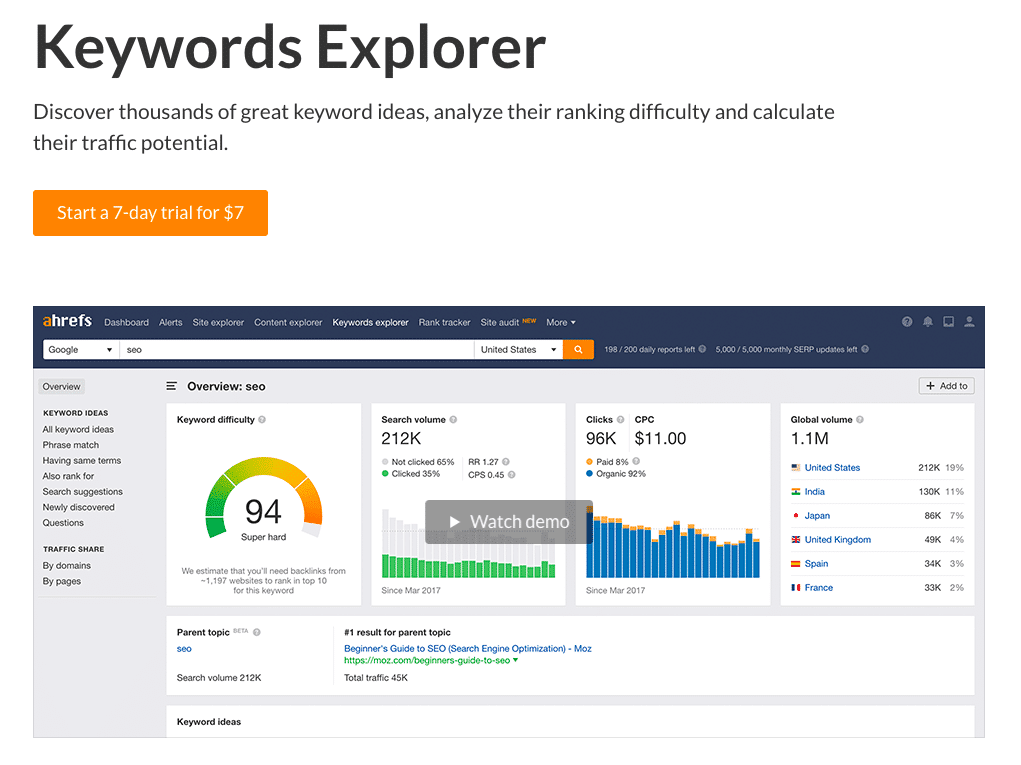
I can spend hours in either of these tools looking for new keyword opportunities. Once you get the hang of it, it can be quite fun. After all, it’s always a good feeling when you find another super high traffic, low competition keyword to add to your list.
Keyword Surfer (Free)
The Keyword Surfer extension is a free keyword research tool I use in a pinch.
If you don’t have the budget for a paid SEO tool, Keyword Surfer is a good start. It will help you determine 1) whether your keywords get traffic, 2) roughly how much traffic your keywords get, and 3) roughly how competitive your keywords are.
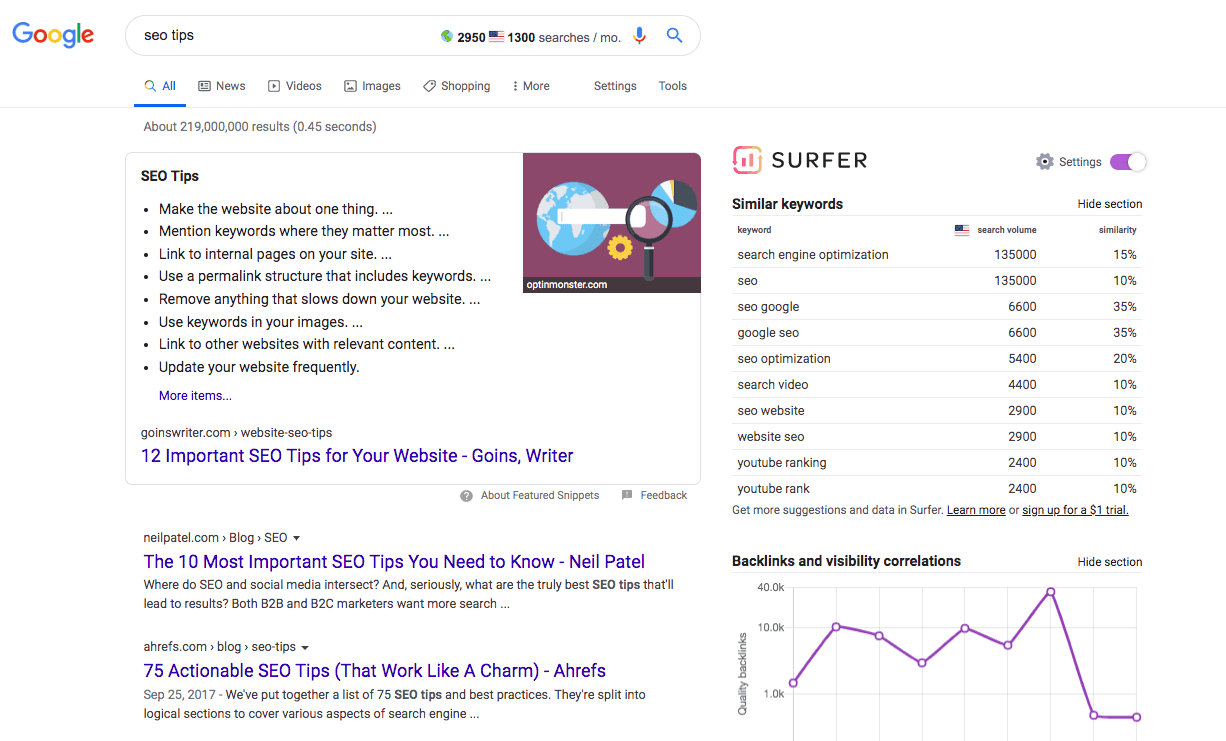
Plus, the tool includes a handy sidebar with some Similar Keywords suggestions you can add to your list.
Simply download the tool to Google Chrome or Firefox and the extension will show you the search volume, competition score, and cost per click data every time you do a Google, Bing, or YouTube search.
Wordtracker (Free)
Wordtracker offers a “freemium” keyword research tool that I don’t personally use myself, but that comes highly rated in the industry. You get a limited number of searches but then can opt for their paid ($27+ per month) plan.
Simply enter your keyword into the search box and Wordtracker will generate a report that includes the relevant keyword data you need. If you want the comprehensive report (that includes perks like Search Trends, SERP Comparison, and live customer support), you’ll want to go for the paid version.
![]()
You NEED to Use a Keyword Research Tool!
All of these keyword research tools will help you further refine your keyword list based on the search volume and competition level. Using a tool IS essential if you want to create an effective SEO keyword list. Otherwise, you may be targeting keywords that are too competitive or get very little traffic at all.
Step 3 – Refine Your Keyword List Based on Comp. Level and Search Volume
Using your chosen tool(s), go through your seed list of keywords and pull up the data for each one. Then, add the search volume and competition level to your spreadsheet.
You may come to find that some of your keywords get low to no search volume at all. That doesn’t mean you should completely remove them from the list, but these keywords likely won’t be your top priority.

There’s little point in creating content for keywords that are unlikely to generate any traffic for you. (Here’s the exception)
For keywords that fall into that low competition, high traffic sweet spot, you’ll want to highlight them and set them as a high priority. In your spreadsheet, you can highlight these keywords in green, for example.
In the next step, you’re going to further refine your keyword list based on each keyword’s relevance and priority level and the user intent behind it.
Step 4 – Organize Your Keywords by Relevance, Priority & User Intent
Just because a keyword falls in the sweet spot, doesn’t mean it’s worth targeting on your site. You’ll still want to make sure that the keyword is relevant and that intent behind the search lines up with what you offer.
For example, say you sell leather-bound architecture sketchbooks.
In your keyword research you find that the keyword “sketchbook ideas” gets decent traffic and isn’t super competitive.
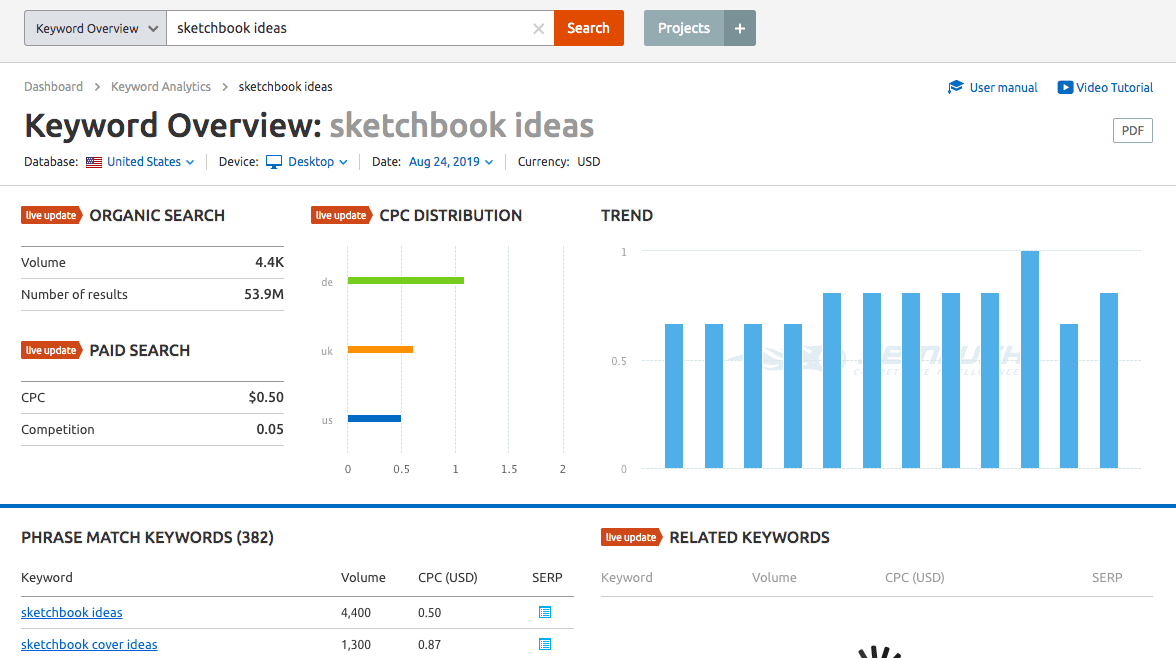
However, when you do a Google search of “sketchbook ideas”, you see that most of the results are suited to newbie artists looking for ideas on what to doodle in their sketchbooks.
The traffic may be there, but the search results appeal to a very different target audience. At the same time, if you were to write a post “11 Creative Sketchbook Ideas”, it’d be unlikely to draw in architects looking to buy a professional sketchbook.
Therefore, the keyword “sketchbook ideas” may not be relevant to your site, nor of high priority for you.
You’ll want to go through your keyword list and highlight the high traffic keywords that are the best fit for your site, based on these criteria:
- The keyword relates to a product or service you offer (Relevance)
- The keyword is something your target audience would be interested in (User Intent)
- The keyword is worth creating content for because it makes sense for your overall marketing strategy (Priority)
I suggest creating a new column on your spreadsheet for each of these categories:
For Relevance, you can include a “Yes” if the keyword is relevant and a “No” if it isn’t relevant.
For User Intent, note whether the user intent seems to be “Inform” (user is looking for info), “Compare” (user is looking to compare options), or “Buy” (the user is looking to make a purchase).
For Priority, note whether the keyword is “High”, “Medium”, or “Low” priority in terms of targeting it in new content on your site.
Avoid creating content for keywords that don’t effectively tie into the overall SEO plan for your site. You’ll save loads of time and money by not targeting keywords your audience aren’t interested in.
Step 5 – Create Your Data-Driven SEO Content Strategy
By now your keyword list includes a solid list of terms that are organized by search volume, competition level, Relevance, Priority, and User Intent. Now the question is, how do they apply to your website content strategy?
It all comes down to the type of content you should create: page or post.
The User Intent column on your spreadsheet will help you in determining whether a keyword should be targeted with a web page or in a blog post.
Pages vs Posts
When users are ready to buy something, they usually expect to find a page that includes a description of the product or service, the price, and a call-to-action to sign up/buy.
But when they are looking for free information, or are wanting to compare different products or services to each other, they are more likely to turn to informative blog posts, reviews, listicles, infographics, or videos.
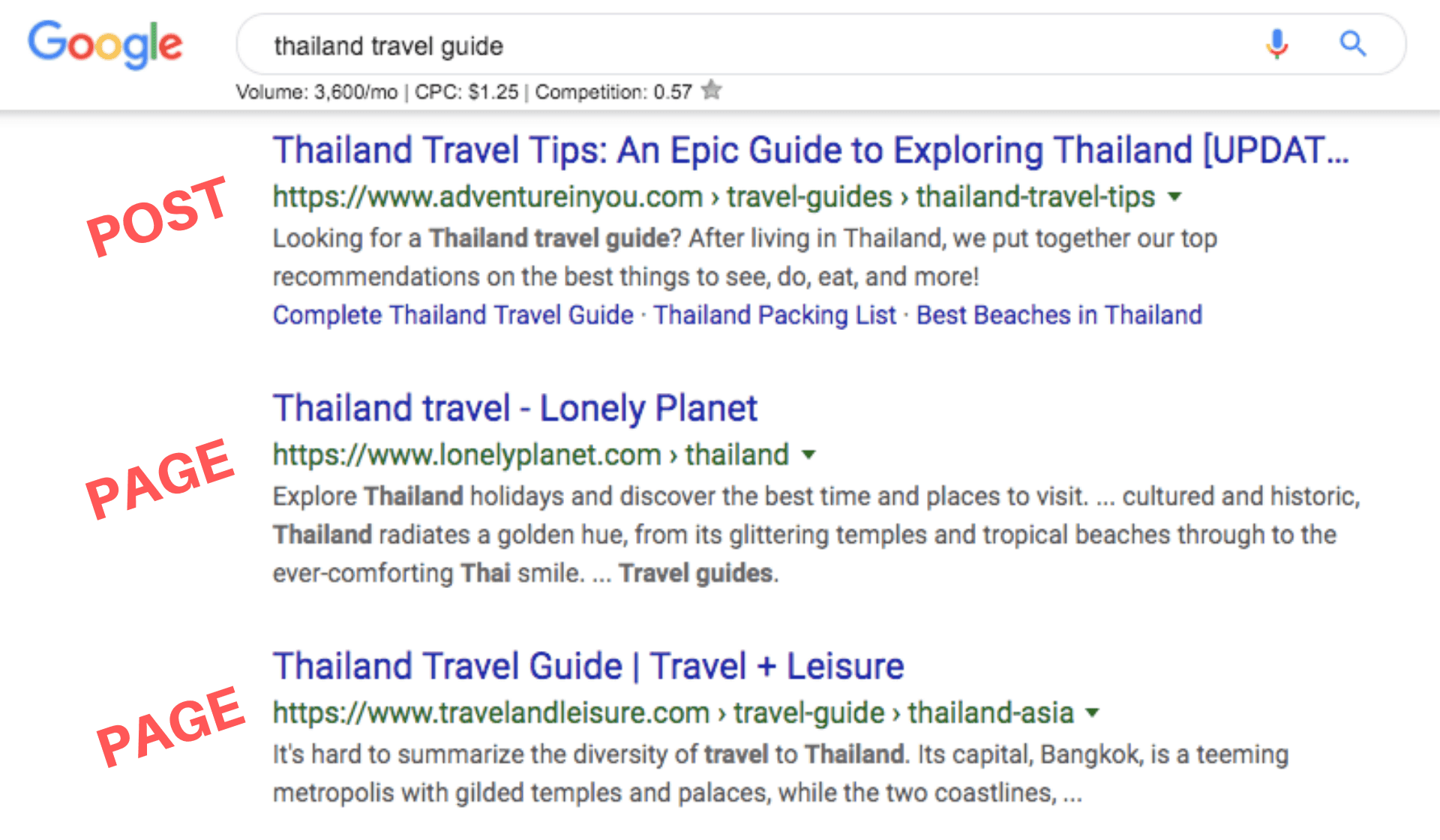
Therefore, in the User Intent behind the keyword has to do with the user looking for more information or comparison guides, you’ll want to create blog content for this keyword.
If, however, the User Intent is clearly to buy, you’ll want to create a page (typically a sales page, product page, service page, or landing page) because these are your “money keywords”.
Tackle the High Priority Keywords First
Your SEO content strategy, then, will consist of a variety of pages and posts you need to create. And since you have already noted their Priority, you know which ones to start with first.
“Money” Pages
The absolute top priority keywords are ones that should be targeted on your product or service pages.

Your website should at least have pages for the services and products you offer. When people search for those “money” keywords, you’ll want these important pages to pop up in the search results. You’ll also want to select the best keywords for your homepage, About page, and Contact page, too.
These keywords are often those that have “buy…” or “where to purchase…” at the beginning, or “… prices” or “… discounts” at the end. It’ll be clear that the user is looking to buy, sign up, or hire.

Foundational Blog Posts and “Evergreen” Content
Next, you’ll want to lay out a plan for creating informative blog content. Tackle those keywords that are likely to draw in users that are looking for foundational information about who you are, what you offer, why you’re awesome, etc.
This content will be your “evergreen” content – that is, content that is fundamental to your website and unlikely to become outdated anytime soon.
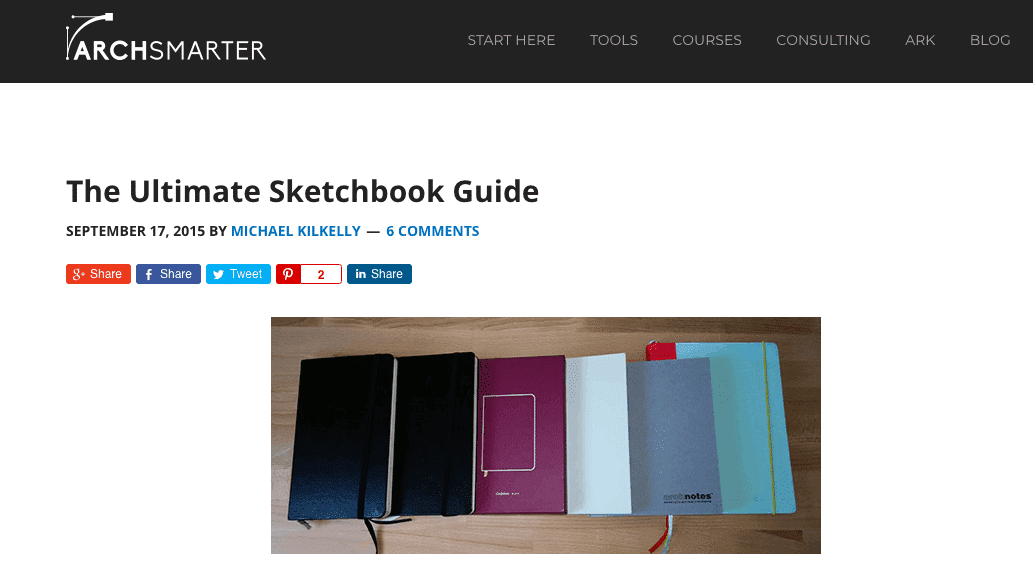
For example, if you’re still in the business of selling sketchbooks to architects, you’ll likely want to write articles like:
- “Why Every Architect Needs a Sketchbook on the Job”
- “10 Best Sketchbooks for Professional Architects”
- “7 Smart and Creative Architecture Sketchbook Ideas”
- “Architecture Sketchbook Pro Review: Pros and Cons”.

These topics (if they have the right keywords to support them) will likely draw in traffic for years to come. You can then funnel users to your “money” pages through internal links or by adding calls-to-action.
All of the data you collected in the previous steps has prepared you for laying out an effective SEO content plan. Now, it’s just a matter of creating the content, optimizing it by following SEO best practices, and tracking the results!
Step 6 – Track Performance of Your Keyword-Optimized Content
You’ve spent allllll this time creating a keyword list. How long will it take for your hard work to pay off?
Not as long as you might think.
If you’ve followed the steps correctly, you’ll have a list of keywords that get a decent amount of traffic while not being very competitive. That means that you won’t have to fight as hard to rank for these keywords.
Of course, you’ll want to follow SEO content best practices to ensure that your content is indexable, keyword-optimized, and user-friendly. Then, it’s only a matter of time before you start seeing traffic roll in.
The amount of traffic you get depends on the search volume behind each keyword you are targeting. If, for example, you’re targeting a keyword that has a search volume of 590, it’s very unlikely that you’ll get thousands of new visitors (unless you also end up ranking for tons of related keywords).
Set Up Google Analytics and Google Search Console
If you haven’t done so already, make sure you have Google Analytics and Google Search Console set up. Each platform includes simple instructions on how to set these up.
These tools will track how much traffic your site is getting, where the traffic is coming from, what keywords you are ranking for, and so much more.
Having this information at your fingertips is the surest way to see if your efforts are paying off. Plus, you’ll be able to see which areas of your website need improvement.

I also highly recommend setting up conversion tracking in Google Analytics to see whether users are converting into buyers, subscribers, or sign-ups as well.
You can also use SEO tools like SEMrush and Ahrefs to track your keyword positions and get an estimation of how much traffic your site is getting.
Need Help? Create Your Google Keyword List the Right Way
Identifying the *perfect* keywords for your SEO content strategy takes practice.
Sometimes you’ll find what seems to be an awesome keyword, just to find out that the competition is too high or the traffic numbers just aren’t there.
Or, sometimes, you’ll target those “sweet spot” keywords, but users just aren’t converting as you had hoped.
The beauty (and struggle) of SEO that it takes trying, testing, and tweaking to get it right. It’s 100% possible to do this on your own, but sometimes it’s nice to get a little help.
At Keys&Copy, we offer done-for-you keyword research to generate a highly targeted low competition, high traffic keyword list that you can use to inform all of your SEO efforts.
You’ll get a laid out plan for what content you should create next and how it fits into the bigger picture of your site. We even offer additional consulting to walk you through what we did and how you can do it on your own.
Apply to get your Custom SEO Keyword List today.
